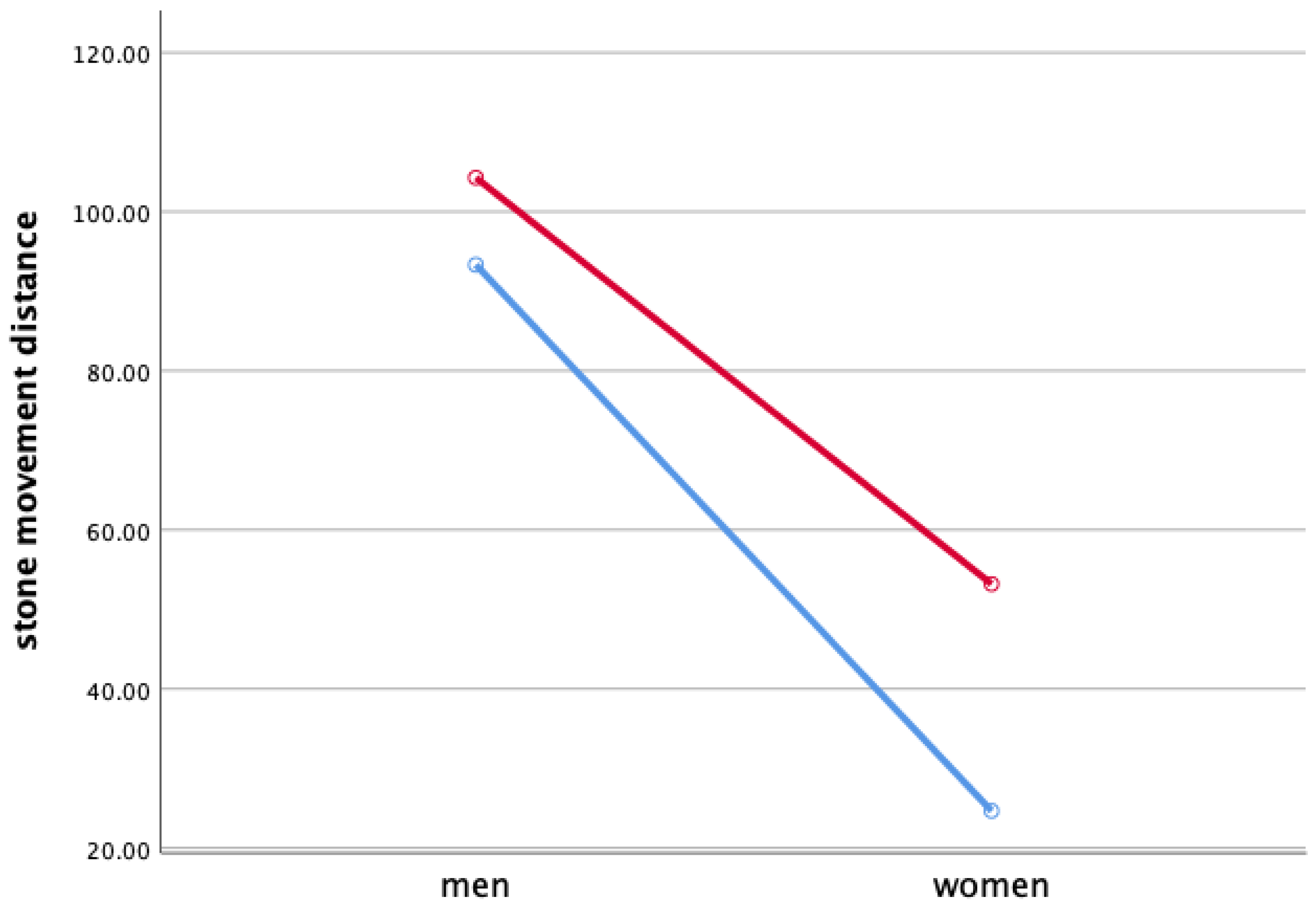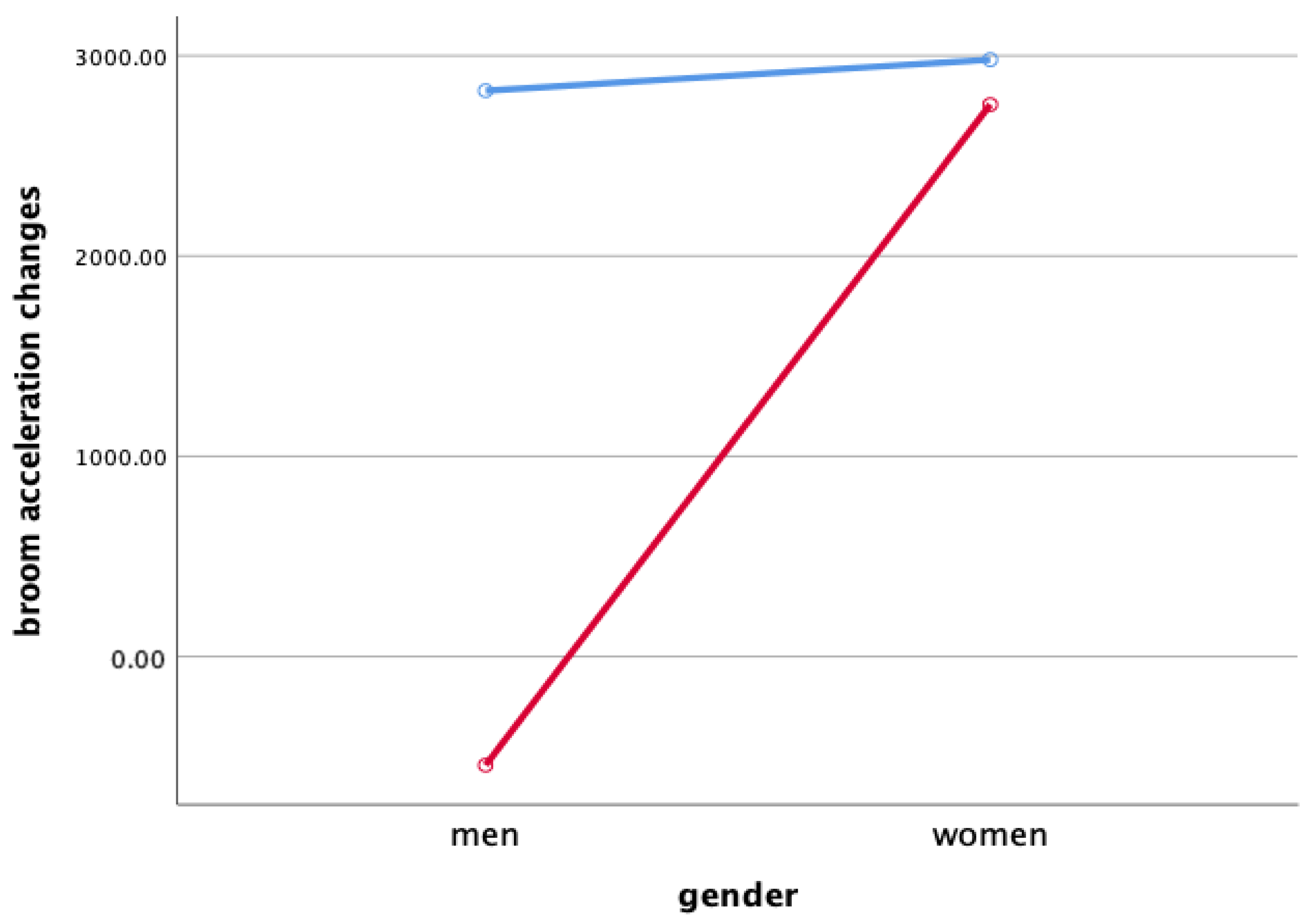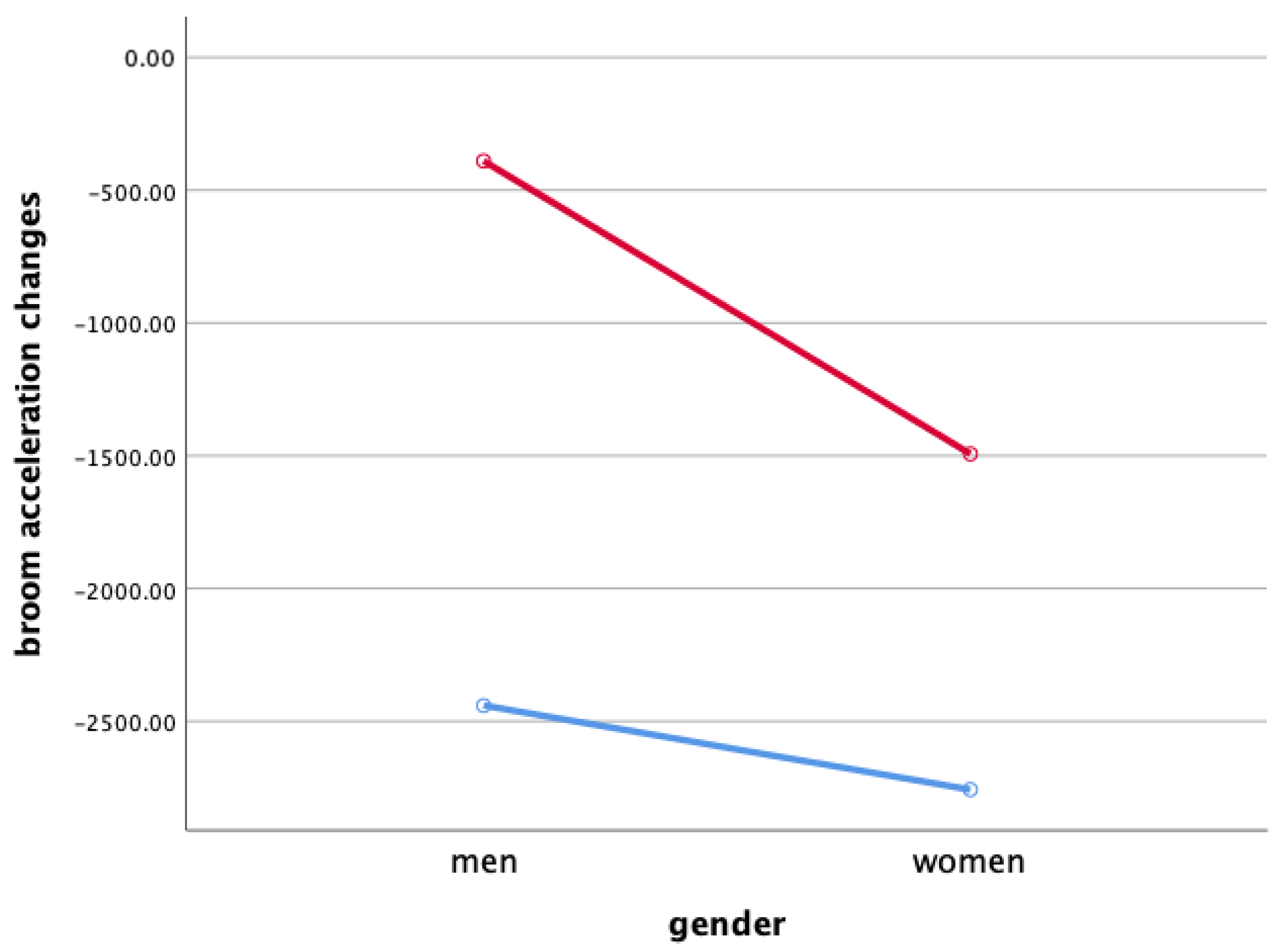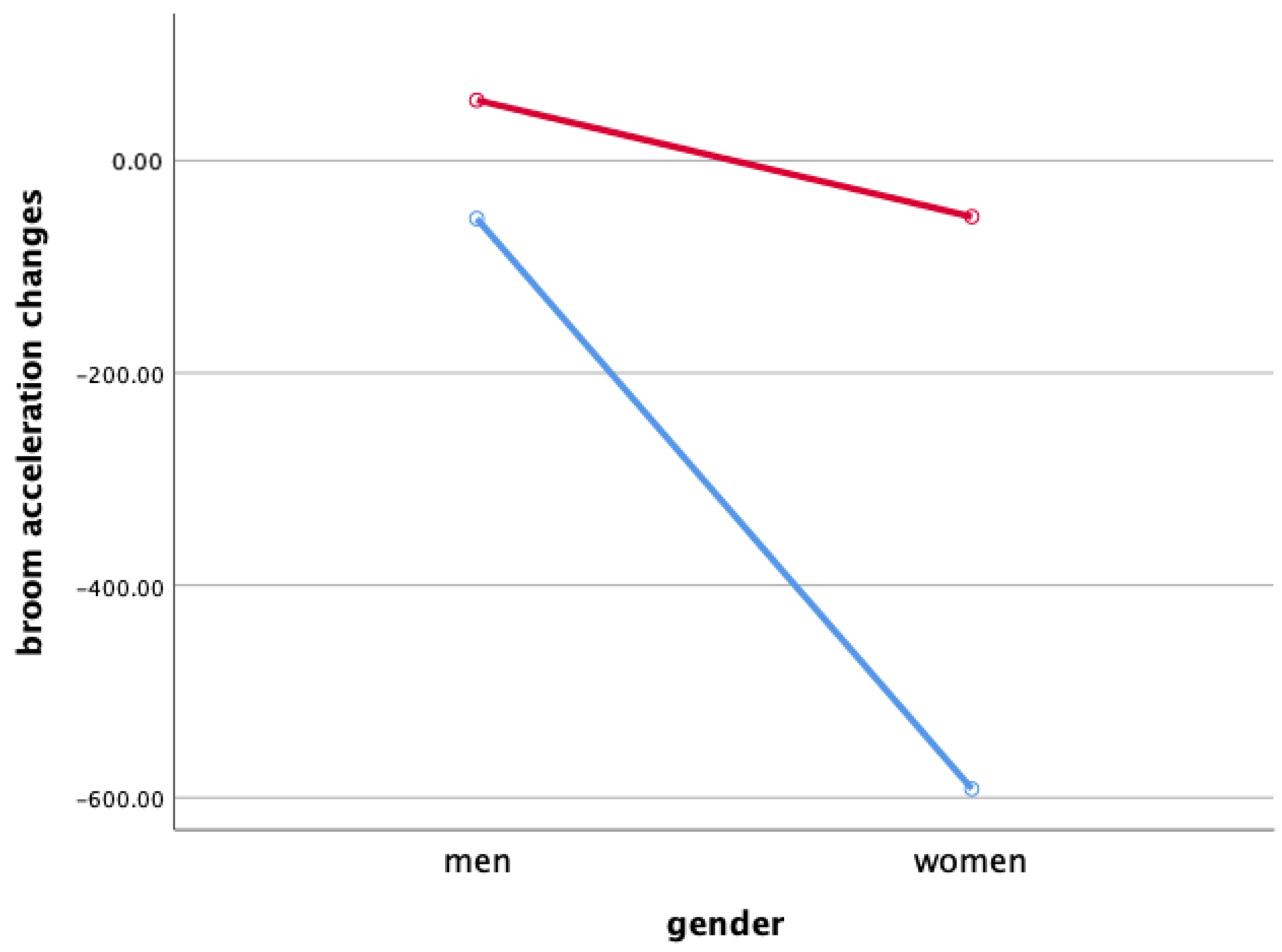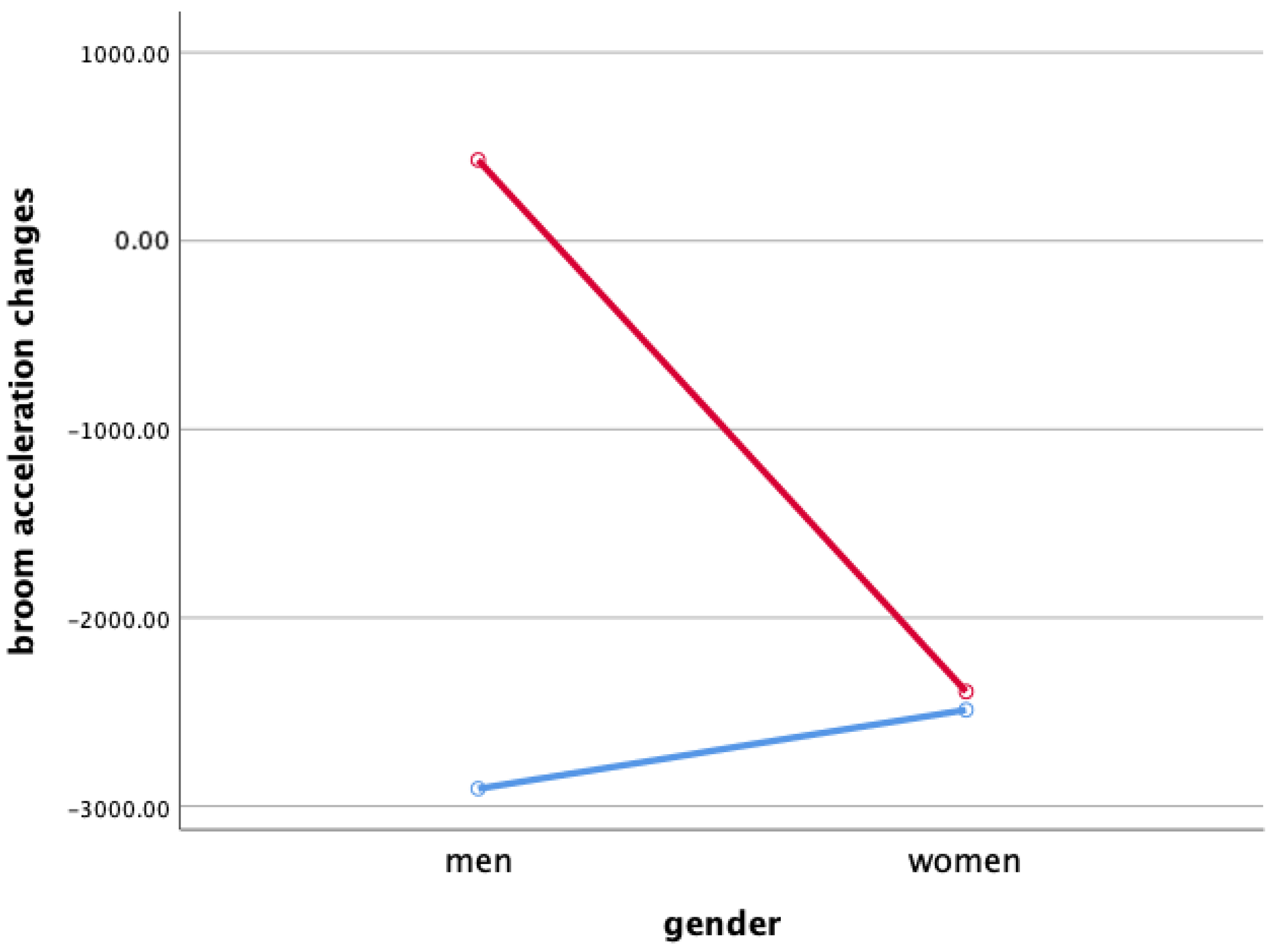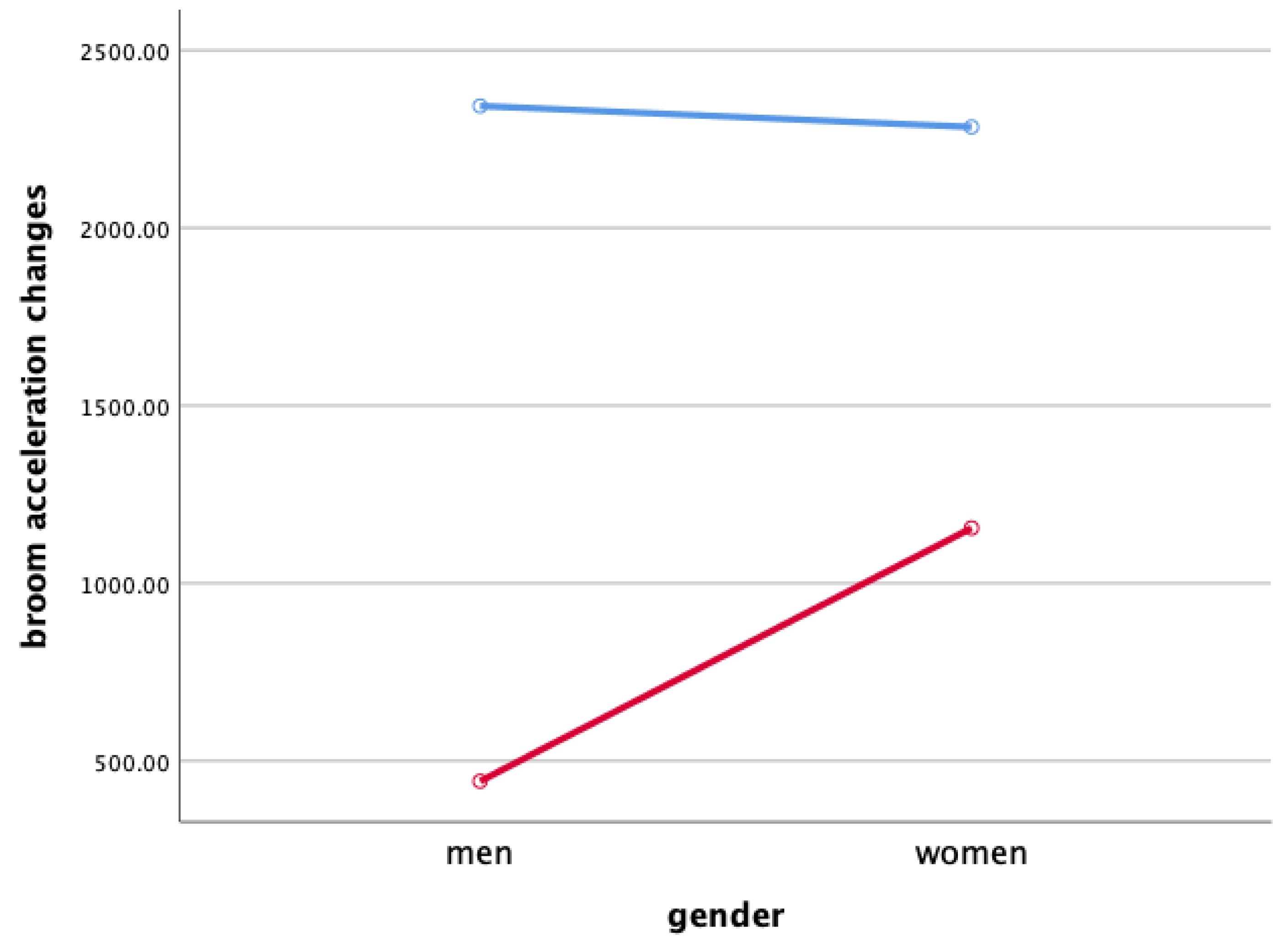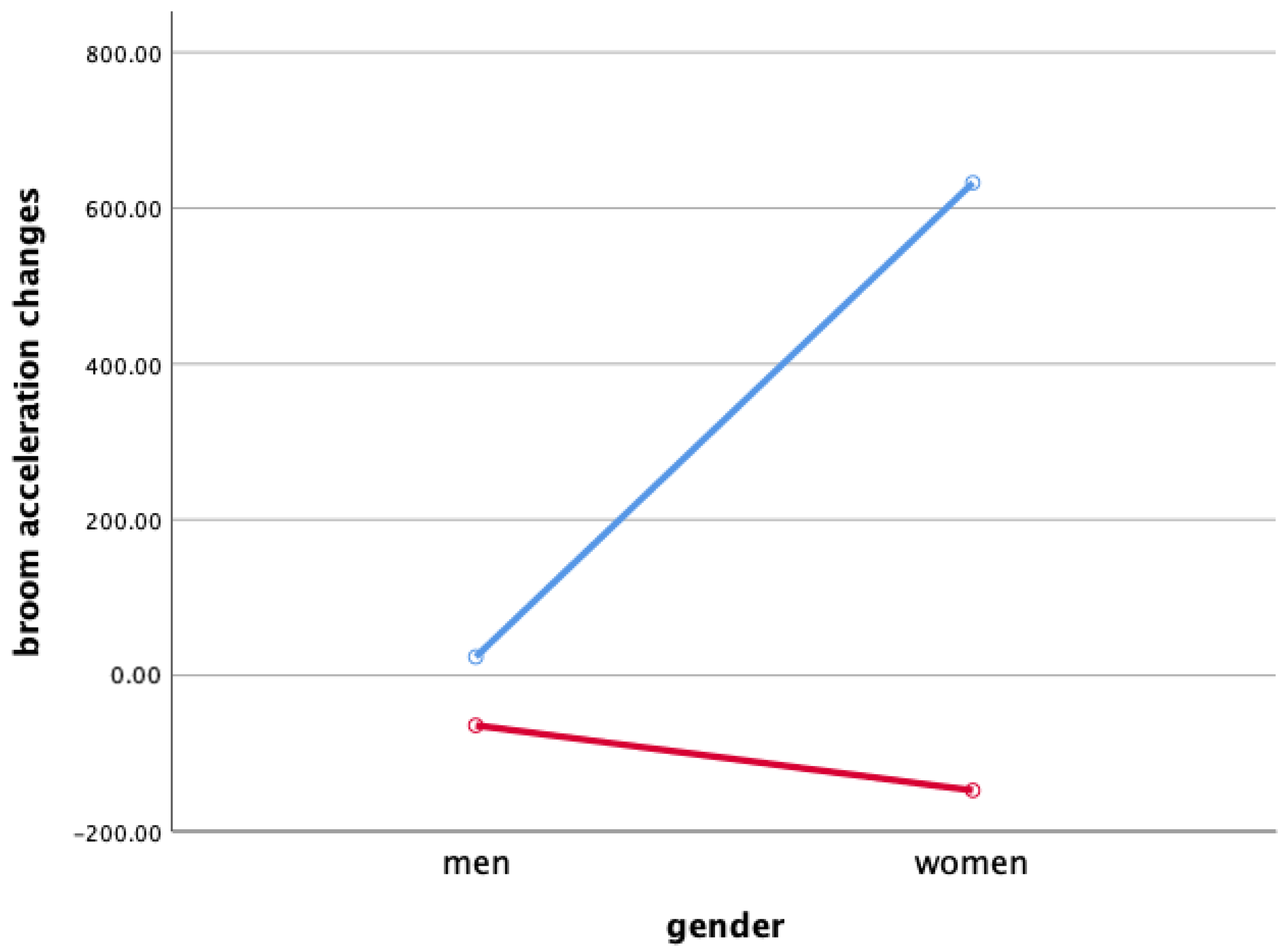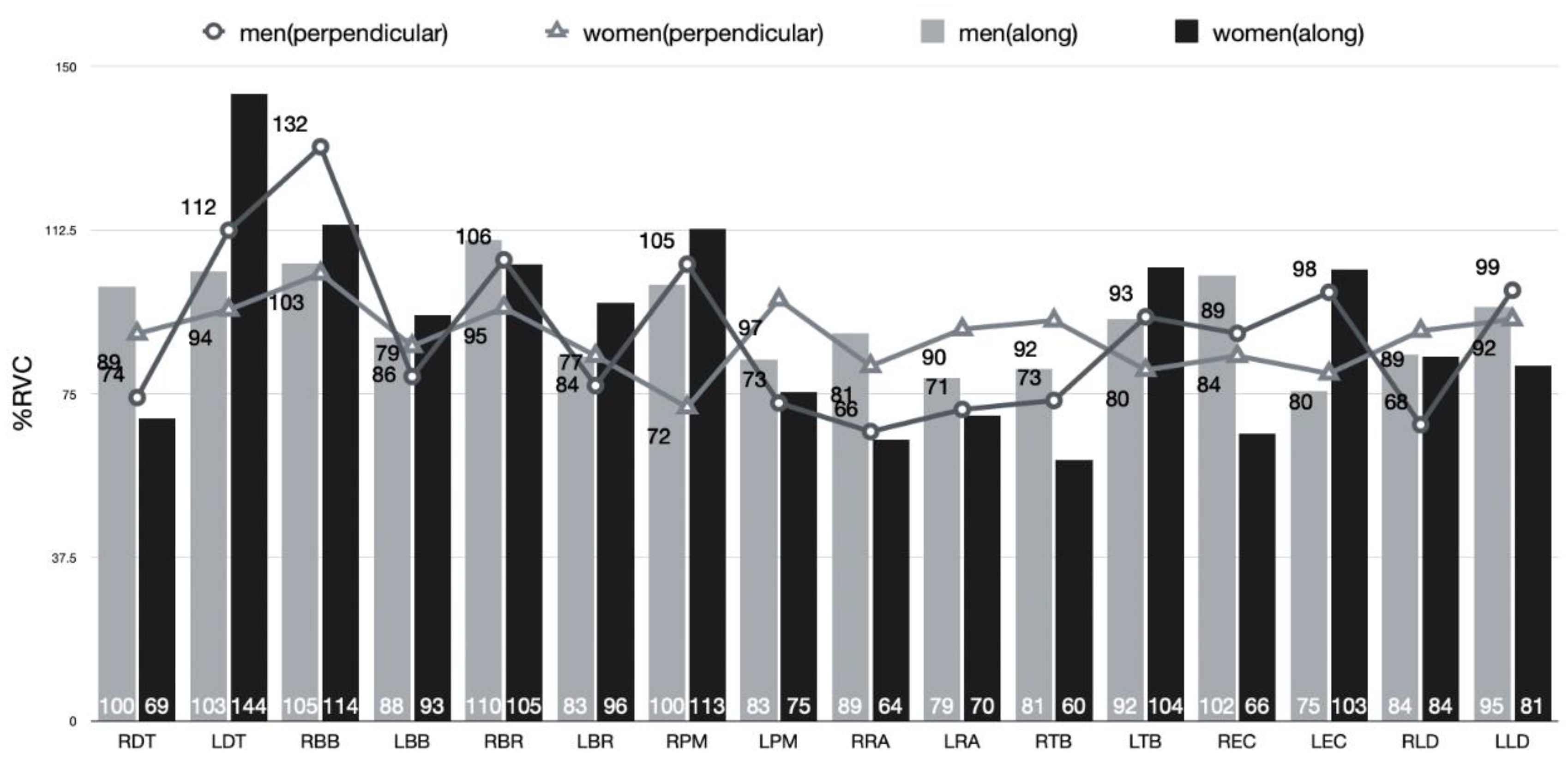1. Introduction
Curling is a team sport in which two or four (mixed doubles) teams are formed to win or lose depending on which team places more stones on a specific location called House on Ice. Four players (Lead, Second, Third, Skip) will push the stone off the ice from the starting line to the house position about 20 m away (Delivery), and the stones pushed from the starting line will then move to the inertia [
1].
Curling is closely related to game performance, such as the state of the ice, the initial speed and the number of rotation of the stone during delivery, and the sweeping speed and position in the sweeping movement, and scientific data and field experience play an essential role [
2]. In particular, various curling factors are determined according to the environmental conditions of ice, and one of them is sweeping. Sweeping is the motion of sweeping the ice floor with a brush in the direction the stone moves. A sweeper determines the ice condition in a curling match and then intimately affects the win or loss of the match, depending on the sweeper’s ability to perform the sweeping. The surface temperature rises for a little while, reduces the stone’s rotation, and allows it to move longer [
3]. To effectively perform such sweeping, it is necessary to determine the stone’s speed and direction, and requires a downward force (vertical load) and fast sweeping speed [
4].
Hitoshi Yanagi et al. [
5] used a self-developed brush tool to measure vertical load during the sweeping to identify the difference between the vertical load forces of the curlers and beginners and reported that the difference between the vertical load forces of the experienced and novice would apply a force of approximately 600 N.
Buckingham et al. [
6] reported that the maximum force of a vertical load was about 400 N. Kim & Chae [
7] reported an average vertical load force of 632.4 N on elite male athletes, and 406.6 N on female athletes was applied. Also, Marmo, Buckingham, & Blackford [
8] said that as the brush head is positioned closer to the player performing the sweeping, the brush head’s vertical load increases. Therefore, it can be said that the pattern of muscle use of athletes sweeping is also essential.
Previous studies on the speed of sweeping, Marmo et al. [
8] reported a speed of 2 m/s, and Bradley [
3] measured the speed of sweeping for elite curlers. It appeared 4.32 times and about 3.81 times per second for women. What can be expected from this study is that when sweeping in the direction of the stone’s movement, the ice surface temperature rises, and a water film is created, which lowers the friction coefficient between the stone and the ice, increasing the distance of the stone. The trajectory can be changed [
9]. In this case, it can be inferred that the maximum vertical load and sweeping speed can effectively increase the ice surface temperature. A study by Marmo et al. [
10] found that strong swiping by Olympic-level male curlers increased the ice’s temperature, thus reducing the friction and that changes in this temperature are affected by the athlete’s sweeping acceleration, vertical load force, and speed of sweeping.
As a result, adjusting the movement distance and trajectory of the stone is a decrease in friction through sweeping except for delivery, and it is considered that it is essential to know the movement patterns of athletes during sweeping. However, there is no research considering athletes’ sweeping characteristics while the ice environment is controlled in curling. Therefore, the purpose of this study is to implement the same ice temperature and air temperature as the Pyeongchang Curling Stadium using an Ice Chamber, and then to analyze biomechanically (temperature change in ice speed, length of stones moved, speed change of tons moved, change in broom speed, and influence of curling athlete’s muscle activity). As we know, it is the first kinematic analysis of curling.
2. Materials and Methods
This study was conducted for four male and four female elite curling athletes, and the selected subjects were only those who voluntarily participated in the study without the leader’s intervention. All curling athletes are from the Republic of Korea national team. Also, all athletes’ average training experience is 6.7 years, and the average age is 23.5 years. The selected subjects have also previously signed an agreement to use personal information and an agreement to participate in research.
The maximum sweeping frequency was controlled based on Bradley’s study [
4] results (4.32 Hz for men and 3.81 Hz for women). In the sweeping method, the brush pad was moved to the maximum in the horizontal (perpendicular to the axis of motion) and vertical (along the axis of motion) directions. An IMU sensor was attached to the Broome to measure the acceleration during maximum sweeping in real-time (1500 Hz). At this time, in order to check the degree of acceleration change in real-time, data was collected in real-time using the MR3 program (Noraxon, Scottdale, Arizona, USA).
The upper left and right deltoids (LDT, RDT), biceps brachii (LBB, RBB), brachioradialis (LBR, RBR), pectoralis major (LPM, RPM), rectus abdominis (LRA, RRA), triceps brachii (LTB, RTB), extensor carpi ulnaris (LEC, REC) and latissimus dorsi (LLD, RLD) selected in this study to obtain electromyograph (EMG) data during sweeping. The skin surface hairs of a total of 16 muscles are removed and then washed with alcohol to remove bipolar surface electrodes (dual-electrode, Noraxon, USA; distance between electrodes: 1.5 cm), and the location of each muscle was selected by referring to the guidelines of Kim Tae-whan et al. (2014). Wireless EMG system (DTS Probe Transmitter, Noraxon, Scottdale, Arizona, USA, sample rates 1500 fixed, input impedance > 100 MΩ, CMRR > 100 dB, Input Range ±3.5 V, center to center distance = 15 mm) to measure actual muscle activity was used. The measured raw data is smoothed to the root mean square (RMS 50 ms) after applying the full-wave rectification to all signals after the bandpass filter 10–350 considering the research subject’s movement smoothing to analyze. Normalization is performed by cutting the start and endpoints of the pushing and pulling motions five times in the entire sweeping motion, and data is calculated based on the average value. Also, RVC (reference voluntary contraction) cuts and specifies until the athletes’ first sweeping has been pushed and pulled six times and normalized accordingly.
In order to realize the same conditions as the Gangneung Curling Center ice environment, the ice information implemented at the 2017 Test Event was collected through cooperation with the PyeongChang Organizing Committee, and the Ice Chamber used the obtained information at the Sports Goods Testing Center of the Korea Institute of Sport Science. Ice Chamber is a device to test the performance of ice equipment. It is equipment that models an ice field’s environment and drives it to measure data such as temperature, speed, friction, and rotational force. As a result of data obtained during 300 curling competitions at Gangneung Curling Center, the average air temperature was 13.3 ℃, and the average ice temperature was −4.0 ℃. Based on this, the average air temperature and the average ice temperature during the experiment in the ice chamber in this study are 13.2 ℃ and −4.2 ℃, respectively, and it can be considered that the environment is similar to the ice environment conditions of the actual stadium.
In this study, after the stone was launched (by a device that automatically shoots at a constant speed) in the ice chamber, the moving distance of the stone, the rate of change in the speed of the stone, the change in the broom acceleration, and the activity of the muscle were measured according to the sweeping method. The spin speed of the stone launcher was set to 300 rpm. Also, the calculated results were presented as mean and standard deviation, and then two-way ANOVA analysis was performed using SPSS 25.0 statistical program (IBM, Armonk, NY, USA). The level of significance at this time is p < 0.05.
2.1. Analysis of Stone Moving Distance When Sweeping
After the stone was launched, the stone’s moving distance according to the presence or absence of sweeping was measured using an along the axis of motion measuring instrument installed in the ice chamber.
2.2. Analysis of the Rate of Change of Stone Speed during Sweeping
After sweeping the stone, the stone’s speed during sweeping was measured using an optical speed meter.
2.3. Broom Acceleration Change during Sweeping
Acceleration was measured through an Inertial Measurement Unit (IMU) sensor (myoMOTION Sensor, Noraxon, Scottsdale, AZ, USA) attached to the broom when sweeping after the stone was fired. At this time, all accelerations according to the sweeping movement method were measured, and the average value of the three-dimensional acceleration variables when pushing and pulling the broom was obtained.
2.4. Athlete’s Muscle Activity (EMG) Changes during Sweeping
When sweeping after the stone was launched, the athlete’s electromyogram was measured according to the direction of the broom movement. For the measured EMG variable, each muscle’s average EMG value expressed at each maximum average acceleration (push + pull) was obtained. Participants provided informed consent, and the procedures were approved by the Institutional Review Board (Korea Institute of Sport Science-Seoul; KISS-1803-018-02).
3. Results
In this study, four male and four female curling athletes were analyzed for the average moving distance variable of the stone according to the sweeping perpendicular to the axis of motion and the sweeping along the axis of motion in the ice chamber.
3.1. Stone Movement Distance When Sweeping
Two-way ANOVA was performed to verify each sweeping type and gender’s main effect for the stone movement distance and the interaction effect between the sweeping type and gender in
Figure 1.
As a result of two-way ANOVA, the sweeping type’s main effect on the stone movement distance was significant. As a result of Bonferroni’s multiple comparisons, the stone movement distance along the axis of motion (M = 78.733) compared to the perpendicular to the axis of motion (M = 58.985) appeared to be high. The main effect of gender was also significant, but the stone movement distance of male athletes (M = 98.796) was higher than that of female athletes (M = 38.922).
As a result, the main effect of the sweeping type was significant (F = 5.085, p < 0.05), and the main effect of gender was also significant (F = 46.737, p < 0.01). Moreover, the interaction effect of sweeping type and gender was not significant.
3.2. Stone Movement Speed When Sweeping
Two-way ANOVA was performed to verify each sweeping type and gender’s main effect and the interaction effect between the sweeping type and gender for the rate of change in stone movement speed in
Figure 2.
As a result, the main effect was not significant in both the sweeping type and gender concerning the change rate of the stone movement speed. Also, the interaction effect of sweeping type and gender was not significant.
3.3. Broom Acceleration Changes When Sweeping
Two-way ANOVA was performed to verify gender and the interaction effect between the sweeping type and gender X (
Figure 3), Y (
Figure 4), and Z (
Figure 5), and the main effect of each sweeping type by when sweeping across X (
Figure 6), Y (
Figure 7), and Z (
Figure 8) axis.
As a result, the interaction effect of sweeping type and gender was not significant. Also, the main effect was not significant in sweeping type and gender for broom acceleration.
3.4. Comparison of EMG between the Gender Condition in Pushing and Pulling Motions during Sweeping
Two-way ANOVA was performed to verify each sweeping type and gender’s main effect and the interaction effect between the sweeping type and gender for muscle activity in a sweeping push and pulling motion (
Figure 9 and
Figure 10).
As a result, there was no significant effect on muscle activity in both sweeping type and gender. Also, the interaction effect of sweeping type and gender was not significant.
